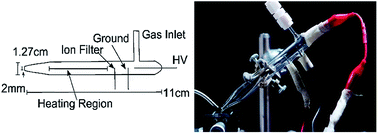Easily fabricated ion source for characterizing mixtures of organic compounds by direct analysis in real time mass spectrometry†
Abstract
The increasing use of atmospheric pressure mass spectrometry has led to the development of many ambient ionization sources, for which sampling versatility and low cost are desired features. One such recent ambient ionization method is direct analysis in real time mass spectrometry (DART-MS), which has proven to be well suited to the analysis of native samples of both simple and complex natures. We describe a home-built DART source (EZ-DART) with versatile sampling capabilities, low power requirements, and low assembly cost which can be easily interfaced to mass spectrometers equipped with an atmospheric pressure inlet. The operating temperature range (22–250 °C) enables the acquisition of both temperature programmed desorption-based DART mass spectra and the collection of multistep collision-induced dissociation (CID) mass spectra. We present here the validation of the EZ-DART source and a demonstration of its performance in a number of relevant applications. Additionally, we introduce the new DART application of reagent assisted desorption ionization (RADI) for the targeting of specific chemical functionality in complex organic mixtures through a host–guest chemical system.

- This article is part of the themed collection: Ambient Mass Spectrometry


 Please wait while we load your content...
Please wait while we load your content...